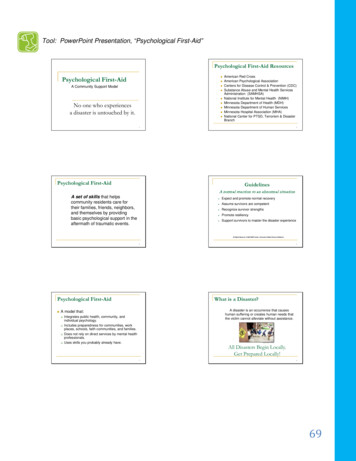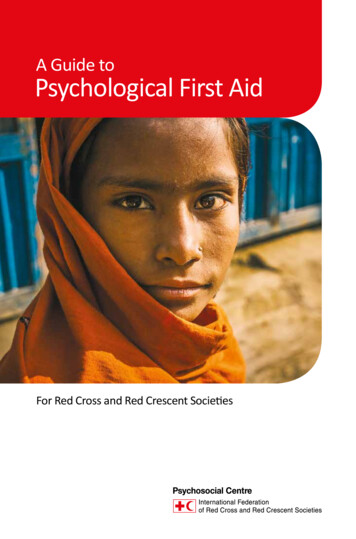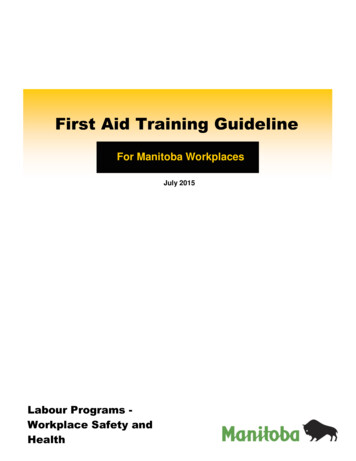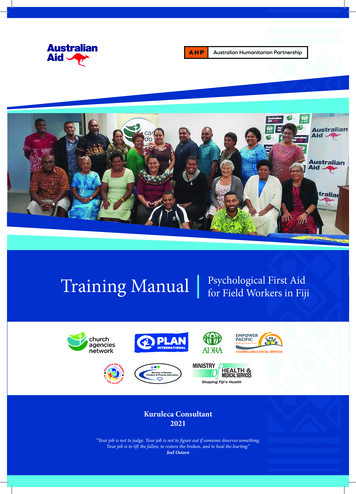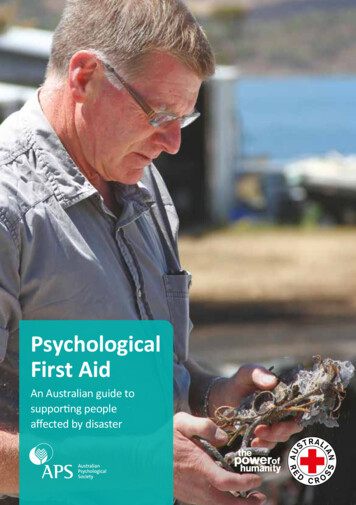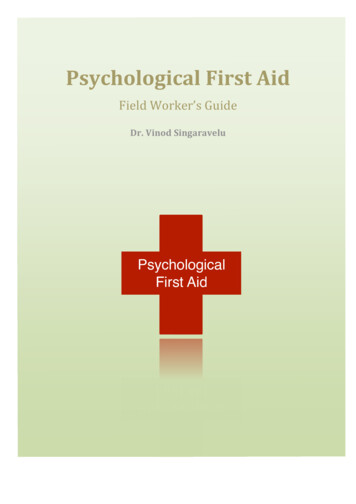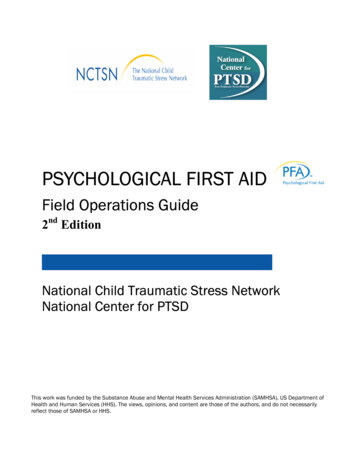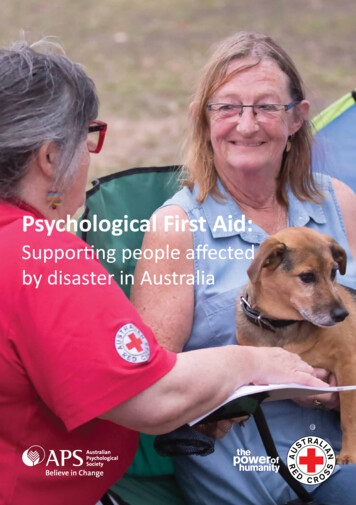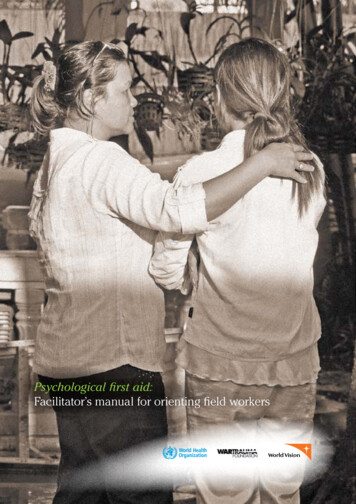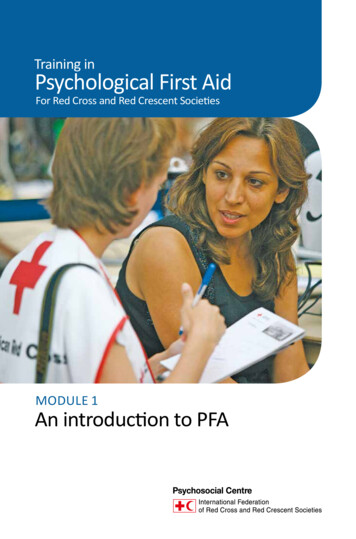
Transcription
Training inPsychological First AidFor Red Cross and Red Crescent SocietiesMODULE 1An introduction to PFA
Training in Psychological First Aid for Red Cross and Red Crescent Societies. Module 1: An introduction to PFAInternational Federation of Red Cross and Red Crescent SocietiesReference Centre for Psychosocial SupportBlegdamsvej 27DK-2100 CopenhagenDenmarkPhone: 45 35 25 92 00E-mail: psychosocial.centre@ifrc.orgWeb: www.pscentre.orgFacebook: www.facebook.com/Psychosocial.CenterTwitter: @IFRC PS CentrePsychological First Aid for Red Cross and Red Crescent Societies was developed bythe IFRC Reference Centre for Psychosocial Support.It comprises: A Guide to Psychological First Aid for Red Cross and Red Crescent Societies A Short Introduction to Psychological First Aid for Red Cross and Red Crescent Societies Training in Psychological First Aid for Red Cross and Red Crescent Societies:· Module 1. An introduction to PFA (4 to 5 hours)· Module 2. Basic PFA (8 to 9 hours)· Module 3. PFA for Children (8 to 9 hours)· Module 4: PFA in Groups – Support to teams (21 hours – three days)Editors-in-chief: Louise Vinther-Larsen and Nana WiedemannAuthor: Pernille HansenAdditional support: Wendy Ager, Louise Juul Hansen, Mette MunkReviewers: Wendy Ager, Ea Suzanne Akasha, Cecilie Alessandri, Eliza Cheung, Ziga Friberg, Ferdinand Garoff, LouiseJuul Hansen, Sarah Harrison, Sara Hedrenius, Elfa Dögg S. Leifsdóttir, Maureen Mooney, Stephen Regel, Gurvinder Singh.We are grateful to the Hong Kong Red Cross Branch of the Red Cross Society of China for their generous support inorganizing the pilot trainings and for their input and feedback on the trainings and on the written materials. We wouldalso like to thank the participants of the pilot training of Module 4: PFA in Groups – Support to teams in Copenhagen,October 2018.We would like to thank Icelandic Red Cross and DANIDA for their funding and support in developing these materials.Look, Listen and Link principles referred to in this guide derive from: World Health Organization, War TraumaFoundation and World Vision International (2011). Psychological first aid: Guide for field workers. WHO: Geneva.Production: Pernille HansenDesign: Michael Mossefin/Paramedia/12007Front page photo: Hector Emanuel/American Red CrossISBN: 978-87-92490-55-1Please contact the IFRC Reference Centre for Psychosocial Support if you wish to translate or adapt any part ofPsychological First Aid for the Red Cross Red Crescent Societies. We welcome your comments, suggestions andfeedback at: psychosocial.centre@ifrc.orgThe IFRC Reference Centre for Psychosocial Support is hosted and supported by Danish Red Cross International Federation of Red Cross and Red Crescent Societies Reference Centre for Psychosocial Support 2018
ContentsIntroduction .4Introduction. 5How to use this manual. 6Preparing for the training. 6Venue. 6Setting up the room. 6Materials. 7Other. 7The training programme. 7The training programme .8The training programme . 9Training sessions . 101. Introduction . 102. Helpful behaviour . 133. Reactions to distressing events. 144. What is PFA?. 155. Look, Listen, and Link. 176. PFA role play. 257. Self-care . 268. Workshop close. 27Appendices .28Appendix A: Icebreakers and energizers. 29Appendix B: Sample training schedule. 30Appendix C: Training resources. 311. A timeline of common reactions to distressing events. 312. Reactions to distressing events. 323. PFA statements. 334. Case studies. 345. Role play feedback form. 35Appendix D: Training evaluation form. 36
IntroductionSWEDISH RED CROSS
INTRODUCTIONIntroductionThis half-day training module introduces participants to basic skills in psychological firstaid (PFA). It is suitable for all Red Cross and Red Crescent staff and volunteers working inany sector. It aims to enable participants to: know what psychological first aid is and what it is not understand the three action principles of ‘Look, Listen and Link’ practise providing PFA to someone in distress be aware of the importance of self-care when helping others.This training module is one of four on psychological first aid, which accompany a set ofmaterials on PFA. These include an introductory booklet called A Guide to PsychologicalFirst Aid for Red Cross and Red Crescent Societies and a small booklet, A Short Introduction to Psychological First Aid for Red Cross and Red Crescent Societies.The four training modules are as follows:T R A I N I N G M O D U L ES1: Introductionto PFA2: Basic PFA3: PFA for children4: PFA in groups –support to teamsHow long does 4-5 hoursit take?8.5 hours8.5 hours21 hours(three days)Who is thetraining for?All Red Cross and RedCrescent Movementstaff and volunteersStaff and volunteerswith some priorknowledge andexperience ofproviding psychosocial supportStaff and volunteerswhose work involvesinteraction withchildren and theircaregiversManagers or otherswho provide care andsupport to staff andvolunteersWhat is itabout?It introducesparticipants to basicpsychological firstaid skillsIt introduces basicpsychological first aidskills and presents arange of situationsfaced by adults, theirreactions to crises,and how helpersmay respondappropriatelyIt focuses on children’sreactions to stress,and communicatingwith children andtheir parents andcaregiversIt is on providingpsychological first aidto groups of peoplewho have experienced a distressingevent together suchas teams of Red Crossand Red Crescentstaff and volunteersEach training module is independent of each other, except Module 4: PFA in Groups- Support to teams training which requires prior participation in Module 2: Basic PFA.AN INTRODUCTION TO PFA · TRAINING IN PSYCHOLOGICAL FIRST AID5
INTRODUCTIONHow to use this manualThis module presents a training programme on basic psychological first aid skills,which can be delivered in 4.5 hours. It uses a wide range of training methods, includingpresentations, active discussions, role play, and group and individual activities.Use your judgment as the facilitator in adapting the training to meet the needs of theparticipants you are working with. This might mean, for example, tailoring the trainingprogramme (the ‘when’) or some of the suggested training methods for different activities(the ‘how’). However, we recommend you keep a variety of methods to cater to all types oflearners and to keep the training active and interesting. We particularly recommend you usemore active forms of training, such as role play, as these facilitate more effective learning.The following icons are used in the manual:IconMeaning of iconTime needed for activityAim of the activityMaterials neededFacilitator’s speechFacilitator notePowerPoint slidePreparing for the trainingIt is important to be well prepared so the training runs smoothly. The following is a checklist of things to consider in preparation.Venue Access to venue, including nearby bus or train stations, parking, washroom facilities, etc. Suitable temperature and lighting in training room with opportunity to darken room ifusing projector or screen.Setting up the room Consider how to set up the room to encourage participation and comfort. Make sure there is enough space to conduct multiple role plays at once (for example,small groups of participants), or additional rooms for people to use. Place a clock visible to all.6TRAINING IN PSYCHOLOGICAL FIRST AID · AN INTRODUCTION TO PFA
INTRODUCTIONMaterials Printed copies of training handouts and manuals Pens or pencils Whiteboard or flip charts with stand Markers Computer and projector, if using power point slides and videos.Other Plan snacks, water, tea and coffee and meals, if provided. Consider if you need a co-facilitator or someone to support you with time management,organization of meal times, or to write down key points from discussion groups on theboard or flip chart. Facilitation skills plus good communication between facilitator and co-facilitatorbenefit participants in the learning they achieve.The training programmeThe training programme provided lists the activities in this module, together with thematerials needed and indicates timings for all the activities. It does not include breaksand mealtimes, or energizers, etc. Make your own schedule and plan to suit local needs.See Appendix A for examples of energizers and Appendix B for a sample training schedule.Conducting role playThere are two types of role play. The first is ‘demonstration role play’ where facilitatorsthemselves act as PFA helpers providing PFA to someone in distress. The second is ‘activerole play’ where participants practise providing PFA to someone in distress. Try to useboth types of role play.Demonstration role plays: It can be helpful to demonstrate a role play twice using thesame case example. The first time, you can role play weaker use of PFA skills and commonhelper errors and the second time you can role play better use of PFA skills. This can helpparticipants learn what to do and what to avoid when providing PFA.Case examples are included in Appendix C for use in active role play. They give background information on the person/s in distress, but are not prescriptive, meaning they donot give specific details on how the participant reacts or responds. Adapt case examplesto suit the cultural and social context in which you are working.Instructions for active role play: Encourage participants to imagine they are experiencingthe situation and reactions described in the case examples, so that they can respond tothe helper’s questions and act realistically. Instruct those playing the role of the personin distress that they should try and pretend to forget what they know about PFA. Theyshould also not make it too difficult for the helpers. This can be frustrating and interferewith learning.AN INTRODUCTION TO PFA · TRAINING IN PSYCHOLOGICAL FIRST AID7
THE TRAINING PROGRAMMEThe training programmeDAMIEN SCHUMANN/ IFRC
THE TRAINING PROGRAMMEThe training programmeModule 1: An introduction to PFAActivityTime(mins)Materials1. Introduction40Flipchart paper and markers1.1 Introduction to PFA10Prepared flipchart of your training schedule1.2 Introduction game201.3 Training programme51.4 Ground rules52. Helpful behaviour15Flipchart paper and markers3. Reactions to distressing events30Copies of Appendix C 1. A timeline of commonreactions to distressing events, copies of Appendix C.2. Reactions to distressing eventsGlue, flipchart paper and markers4. What is PFA?20Copies of Appendix C. 3. PFA statements5. Look, Listen, Link905.1 Introducing the action principles55.2 LOOK155.3 LISTEN15A. Active listening25B. Calming someone in distress5LOOK: Flipchart with actions for LOOK plus copies ofAppendix C. 4. Case studiesLISTEN: Prepared flipchart with actions for LISTENLINK: Prepared flipchart with actions for LINK pluscopies of Appendix C. 4. Case studiesFlipchart paper, markers, pens, and paperC. Asking about needs and concerns andhelping to address immediate needs andproblems105.4 LINK156. PFA role play45Copies of Appendix C: 5. PFA action principlesAppendix C: 6. Role play feedback forms7. Self-care15Flipchart paper, markers, contact details of teamleaders, volunteer managers, etc.8. Workshop close5Appendix D: Training evaluation formsAN INTRODUCTION TO PFA · TRAINING IN PSYCHOLOGICAL FIRST AID9
THE TRAINING PROGRAMMETraining sessions1. Introduction1.1 Introduction to PFASLIDE 14010To introduce PFA to participants.None1. Welcome the participants and introduce the facilitators. Explain participants willhave a chance to introduce themselves in the next activity.2. Ask participants to pair up and to discuss for two minutes what they know aboutpsychological first aid (PFA).3. After two minutes, ask them to share what they know about PFA. If none of theparticipants are familiar with PFA, you can start by asking them what they knowabout physical first aid, and then what they think PFA is.4. Summarise their responses and explain:Psychological first aid is a set of skills and attitudes for helping people indistress who need support to manage their situation and cope with immediatechallenges. Once you have learnt these skills, you can use them both in your personaland working life when responding to a crisis.5. Now give the pairs two minutes to discuss what kinds of situations might leadsomeone to need psychological first aid.6. Ask them to share some of their suggested situations with the large group.Examples could be when someone: finds out they have a serious illness is in a car accident is assaulted or experiences other forms of violence witnesses something frightening or traumatic experiences a disaster, like an earthquake or a flood loses a loved one.7. Highlight that distressing events can be individual and personal, for example whensomeone is going through a divorce or has lost a loved one. They can also be public andaffect many people together, for example due to a natural or human-relateddisaster.8. Continue by explaining:When we experience frightening or distressing events like the ones you havementioned, we react with our bodies, thoughts, and our feelings. This is normal. It isimportant to understand this. Everyone reacts when they go through something stressful and difficult. Most people recover from difficult experiences by themselves or withthe help of friends, family, or others. Psychological first aid involves knowing commonreactions to distressing events and how to help people cope with these reactions.10TRAINING IN PSYCHOLOGICAL FIRST AID · AN INTRODUCTION TO PFA
THE TRAINING PROGRAMMEPsychological first aid can help people in distress cope better emotionally andpractically, and in this way helps to reduce negative impacts of distressing events.Part of psychological first aid is helping the affected person access social support,which can help to reduce stress and improve recovery.Today you will learn about the three action principles, ‘Look, Listen and Link.’ Theyare easy to remember and are useful prompts in providing PFA to someone in distress.Some people may need more help than can be provided by psychological first aid. Partof learning psychological first aid skills is learning how to recognize when someoneneeds other types of help, and knowing who to contact to refer the person in distress.We will talk more about this later in the training1.2 Introduction game20To introduce the participants to each other and promote a friendly andcomfortable atmosphere.To introduce the three action principles of PFA, Look, Listen and Link.None1. Start by asking the participants to stand in a circle. Explain that you will now play agame for the participants to learn a little more about each other.2. Ask everyone to walk around the room and to LOOK for a partner they have something in common with. It must be something they can see. For example, they couldbe wearing the same colour t-shirt, or they have the same coloured hair, or eyes, etc.3. When everyone has found a partner, tell them to ask the other person’s name andprepare to introduce the other person to the larger group.4. Call everyone back to the circle and invite each person in turn to introduce theirpartner to the entire group.5. Now ask everyone to repeat the activity and find a partner, but this time they needto find someone by LISTENING. Give participants a few minutes to talk with oneanother. The aim is to LISTEN to find someone they have something in commonwith, for example, the same number of children, or they live in the same area, or theylike the same music etc.6. When everyone has found a partner, ask them to come back to the circle and sharewith the group what they have in common.7. Now ask everyone to walk around for the last time and again find a new person totalk to. The last task is for the entire group to create a human chain where they allLINK together through things they have in common. This means once a pair has foundsomething they have in common, they stick together, and go and look for another pairthey can link to who they have something in common with. When the entire grouplinks at the end, it will be about something they all have in common – for example,that they are all at the training.8. For example: Tomas links to Jessie because they both like reading. Ezra and Mahalink together because they both like classical music. Tomas, Jess, Ezra and Maha linktogether because they all like to eat pizza. And so on.9. When they have formed a human chain, ask them to link it into a circle. End theactivity by explaining that they have now practised the three core action principlesof psychological first aid of ‘LOOK, LISTEN and LINK.’AN INTRODUCTION TO PFA · TRAINING IN PSYCHOLOGICAL FIRST AID 11
THE TRAINING PROGRAMME1.3 The training schedule5SLIDE 1To orient participants to the training programme.Flipchart with the training programme written on it or copies for each participant1. Go through the training schedule on the flipchart or powerpoint slide and brieflyexplain each activity.2. Provide participants with any practical information, such as start and finish times,meal breaks, where to find washrooms, etc.3. Explain that this is a short training in basic PFA skills, which means it does not covertopics such as how to handle complicated situations, or how to provide psychologicalfirst aid to children or groups of staff or volunteers. These topics are covered in othertraining modules that can be arranged at another time.1.4 Ground rules5To agree ground rules to create a safe environment for the group.Flipchart paper and markers1. Explain that it is important that the group agrees ground rules for the workshop to createa safe environment where everyone can feel comfortable participating and sharing.2. Ask participants to make groups of three, and give them one minute to discuss whatrules they think are important for this group.3. Invite the groups to contribute the rules they have chosen, and write these on a flipchart. Ask the groups not to repeat rules that other groups have already mentioned.Examples of good ground rules are: Turn mobile phones off during training. Respect punctuality. Start and end on time, return promptly from breaks. No interrupting. Respect each other, including personal boundaries. Everybody is invited to share his or her point of view but nobody is pressured to speak. Listen with full attention. When others share experiences, show a non-judgmental attitude. Let facilitators know of any difficulties. Questions are encouraged. Keep everything that is disclosed in the group confidential.4. Highlight the importance of confidentiality and keeping personal information sharedin the training within the group. This will encourage an open atmosphere of trust andmake participants feel comfortable and safe to share personal stories and feelings.5. Tell participants they do not have to participate in all activities. If they feel uncomfortableabout participating in an activity, they can step back and observe.6. Display the sheet with the agreed ground rules where everyone can see it clearly duringthe workshop.12TRAINING IN PSYCHOLOGICAL FIRST AID · AN INTRODUCTION TO PFA
THE TRAINING PROGRAMME2. Helpful behaviour15To encourage participants to think of what helps a person in distress.Flipchart paper and markersIf you have a co-facilitator or volunteer from the group, ask them to writethings on flipcharts so you can focus on what is being said.1. Ask the participants to individually think of a time in their life when they experiencedsomething unexpected that was more difficult than usual to handle and led to distress.2. Now ask them to think about whether they received help from one or more peoplewhen they had this experience. Ask them to think about what this person, or persons,did to help them and what it was that was helpful or unhelpful.3. Invite participants to share some of their reflections on what was helpful and what wasnot helpful. Make sure they do not go into detail about the difficult experiences thatled to them receiving help, but to keep focus on the help they received.4. Ask your co-facilitator or volunteer to write down on the flipchart some key wordsfrom what participants say. Organise the responses into two columns headed ‘Helpful’and ‘Not helpful.’The box on the right shows examplesof what participants might say:5. Use these responses to show thatdifferent things are helpful in differentsituations and for different people.Someone who is in a state of shockmay find it helpful that a friend takescontrol of the situation and takes careof practical matters. However, anotherperson might find the same actionunhelpful because it makes them feelpowerless and unable to cope.HELPFUL Listenedcalmly Called myfamily Broughtme a glassof water Tookcontrolof thesituationNOTHELPFUL Startedpanickingherself Tookcontrol ofthe situation Interruptedall the time Talked aboutthemselvesAN INTRODUCTION TO PFA · TRAINING IN PSYCHOLOGICAL FIRST AID 13
THE TRAINING PROGRAMME3. Reactions to distressing events30To discuss common reactions to distressing events.Reference to Appendix C: 1. Timeline of common reactions to distressing events(for an example of a timeline with reactions),Copies of Appendix C: 2. Reactions to distressing events,scissors, glue, flipcharts and markers.Read Reactions to crises in the introductory book A Guide to PsychologicalFirst Aid for Red Cross and Red Crescent Societies.1. Ask participants to reflect for a few minutes on the difficult experience they justthought about and how they reacted to this event.2. Now ask them to form groups of four and to sit together where they can work comfortably on a flipchart together. Give each group a flipchart and marker but tell them towait for instructions on what to use them for.3. Start by asking the groups to discuss how people usually react when they experiencedistressing events. Give them a few minutes to do this, and then ask them to alsoreflect on how reactions change with time.4. Draw a blank timeline on a flipchart (see the example in Appendix C: 1. Timeline ofcommon reactions to distressing events). Ask each group to draw this timeline on theirflipchart paper.5. Now give each group copies of the handout (Appendix C: 2. Reactions to distressingevents.) Explain this is a list of common reactions to distressing events, but they mayknow of others that are not on this list.6. Ask the groups to plot thereactions on the list onto theirtimeline. Encourage them to addany others that may not be listed,if they think these reactions arecommon. Tell participants theycan plot a reaction multiple timeson the timeline if needed.Reactions after a distressing event7. Give the participants about fiveminutes to work on this.8. When the groups have completedtheir timelines, ask them todisplay all the flipcharts next toeach other. This can be on a wallor on the floor. Give participantsa few minutes to look at thedifferent flipcharts.AngerShockTime ofevent14TRAINING IN PSYCHOLOGICAL FIRST AID · AN INTRODUCTION TO PFANothingis realNextdayAngerSadA fewdays later
THE TRAINING PROGRAMME9. Ask participants what similarities or differences they see in each other’s timelines.10. After all groups have contributed, summarise the discussion and highlight that: Reactions differ: There is not one standard reaction to distressing experiences.People react in different ways. Timing of reactions differs: Reactions change over time. Some people react calmlyduring or immediately after an event. However, they may become distressed days,weeks or even months after the event, whilst others react very strongly at the time ofthe event.11. Explain that how someone reacts depends on many factors. Ask the participants whatthey think influences people’s reactions to stressful events. List the different factorsmentioned. Make sure the following are all included: the nature of the event – what happened and how have people been affected the severity of the event – how severe the consequences were, especially in terms ofloss and life changes how long the event took whether they experienced something similar before what kind of support they have their physical health their pre-existing state of mental health their cultural background and traditions, which impacts their behaviour, expressionand communication their age (for example, children of different ages react differently than adults).12. Conclude this session by saying:Most people who experience distressing or traumatic events have commonreactions and recover well, especially if they can restore their basic needs and receivesupport from people around them. Others may have very strong reactions and needmore specialised help. We will discuss this in more detail later.4. What is PFA?SLIDE 2-320To learn more about what PFA is and what it is not.To stimulate discussion on who can provide PFA, when it is given and where itcan be provided.Copies of Appendix C: 3. PFA statementsUsing the set of PFA statements, prepare enough cards for all participants. Itis OK if two participants have the same statements.1. Start by summarising the information the participants have already received aboutPFA. You can say:Psychological first aid is a set of skills that you can use to cope with distressingsituations and events. You can use psychological first aid skills to deal with your ownexperiences and to support others who are in distress, so that they can understand andcope better.AN INTRODUCTION TO PFA · TRAINING IN PSYCHOLOGICAL FIRST AID 15
THE TRAINING PROGRAMMEPsychological first aid aims to reduce the initial distress someone feels after a difficultevent or experience. It provides for a person’s practical and basic needs, such as helpingsomeone find somewhere to stay if they have had to leave their home or helping themcontact family or other help.It involves assisting someone in distress to manage their situation and be able to makeinformed decisions, so they can adjust and cope with the challenges they are facing.Psychological first aid skills involve recognising when someone is in distress, and takingaction to help them. What action you take depends on the situation and what help theperson needs, and is likely to differ every time you help someone.2. Now give each participant a card with one of the PFA statements. Explain there are twotypes of statement – one that describes what PFA is, and one that describes what it isnot. Tell participants to walk around and find out what others have on their cards,and to make two groups corresponding with the two types of statement. Dependingon the number of participants, there may be two people with the same statements.They should be in the same group.The two lists are:PFA is (true) comforting someone who in distress and helping them feel safe and calmassessing needs and concernsprotecting people from further harmproviding emotiona
This training module is one of four on psychological first aid, which accompany a set of materials on PFA. These include an introductory booklet called A Guide to Psychological First Aid for Red Cross and Red Crescent Societies and a small booklet, A Short Introduc-tion to Psychological First Aid for Red Cross and Red Crescent Societies.


